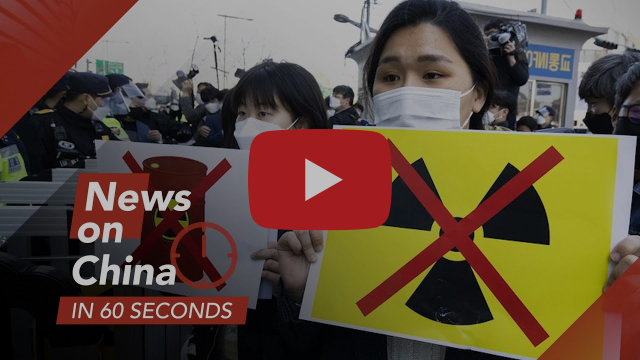

South Koreans protesting Japan’s decision to release radioactive wastewater into the Pacific Ocean, 14 April 2021 [Xu Ruxi/Xinhua]
Subscribe to News on China. The digest is published every Saturday in English, Spanish, Portuguese and French.
Watch the News on China in 60 Seconds by clicking on the image above, and subscribe to our YouTube channel.
Read the News on China: Africa Weekly in English, Spanish, Portuguese and French.

Geopolitics
Japan announces release of Fukushima’s radioactive water (1.25 million tons) into the sea by 2022, condemned by China and neighbors
2011 earthquake and nuclear reactor meltdown contaminated water with 860 trillion becquerels (unit of radioactivity) of tritium, which cannot be filtered out; Taiwan, South Korea, environmental and fishing groups criticize US-endorsed decision
South China Morning Post, 13.04.2021
South China Morning Post, 18.04.2021
Australia revokes agreement between Victoria state’s Belt and Road agreement with China, escalating bilateral diplomatic tensions
Canberra used federal veto power for the first time to nullify agreements with China, plus scientific cooperation with Iran and Syria; Australian exports to China (US $112.2 billion, 2020) fell 40% last month, excluding iron ore
South China Morning Post, 21.04.2021
South China Morning Post, 20.04.2021
China decreases Australian beef imports by 25% and increases imports from South America (February 2020-January 2021)
Due to trade tensions and low Australian production, China turns to the South American market, increasing beef imports from Brazil (+109%) and Argentina (+29%), whose prices are about 50% lower than Australia’s

Economy
Chinese state-owned companies’ profits (US $63.7 billion) triples in the first quarter, hitting record high for the period
Part of Chinese economic recovery, increased investment in infrastructure (29.7%) – especially roads and railways – and real estate (25.6%) benefited SOEs, which generated US $1.2 trillion in revenue (+30.1%)

National Politics
Central bank researchers recommend full liberalization of childbirth to address shrinking labor force and aging population
Birth rate decreased from 6.7% to 1.7% (1950-2019) – much faster than Western nations – causing declining working-age population since 2010; immigration policies, investing in countries with younger workforce and creating conducive child-rearing environment are encouraged
China approves US $23.84 billion budget for agricultural industrial development, combining poverty alleviation and rural revitalization programs
Country established 2.24 million peasant cooperatives and over 300,000 industrial bases in once-impoverished counties; program will help develop local production such as mushrooms, strawberries and daylily flowers

Agriculture and Environment
Government implements ten-year Yangtze River fishing ban, and invests US $3.84 billion in compensation and subsidies to fishworkers
Since 1 January, restriction aims to recover aquatic biodiversity damaged by overfishing and pollution, affecting 231,000 fishworkers – 56% of whom were transferred to other sectors and 74% received social security (US $30,000)
More than 300,000 “stream administers” oversee efforts to conserve water systems nationwide at the grassroots level
Administers monitor water quality, drainage and sewage systems, and illegal activities; Shanghai’s 7,000 people oversee 47,000 streams, helping to create 50 ecological water networks (2022), but supervision of sewage, illegal boats and construction needs improvement

People’s Life and Culture
Automation in “smart mines” improves working conditions in China, world’s leading coal, gold and rare earths producer
200 smart mines have improved extraction efficiency and reduced energy-intensiveness and emissions, but expensive technology, lack of skilled workers and millions of illegal mines are challenges; mining fatalities decreased from 6,995 to 333 (2002-18)
Dafen village became the world’s largest oil painting reproduction factory after economic reform, now turning to online market
Initiated by Hong Kong art dealer Huang Jiang in 1989, the small village (0.4km2) became mass producer of 60% of world’s oil paintings, with over 1,200 galleries and 8,000 painters generating US $670 billion (2019) output

Dafen’s peasant painters featured in “China’s Van Goghs” documentary, 2016 [Jiemian]





